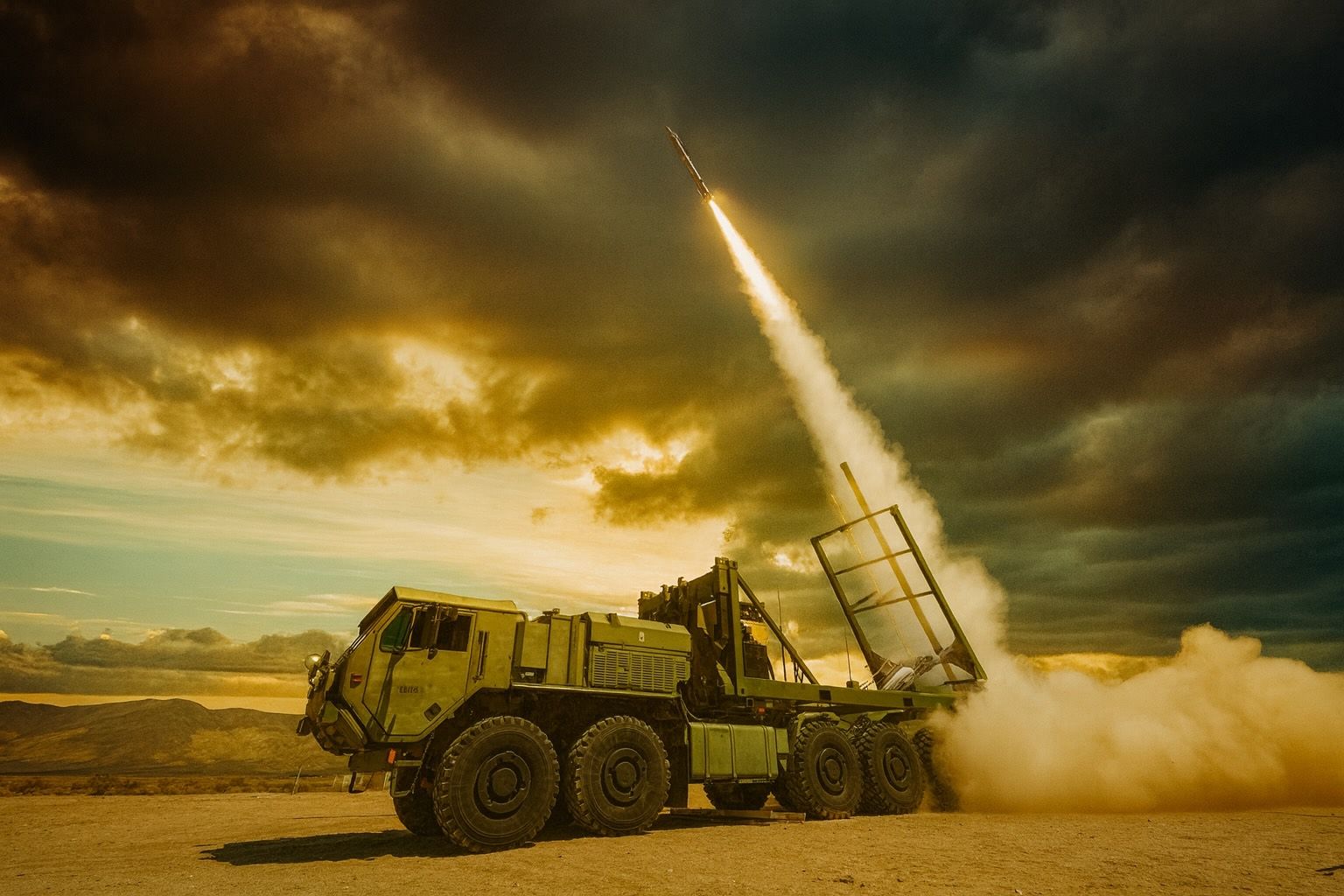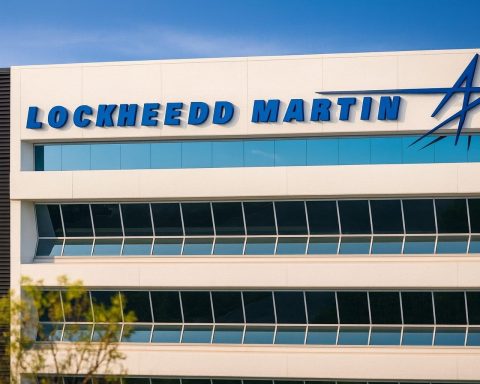- Hypersonic Integration Contracts: Defense startup Castelion has secured U.S. Army and Navy contracts to integrate its new “Blackbeard” hypersonic strike weapon onto operational platforms [1]. It marks the first step toward deploying these powerful, nearly unstoppable missiles around the world [2].
- Mobile Launchers (HIMARS): The U.S. Army will work with Castelion to mount Blackbeard on mobile launchers like the HIMARS (High Mobility Artillery Rocket System) [3]. Army budget documents show Blackbeard Ground Launch (GL) is compatible with existing HIMARS launchers as an interim solution, even as new autonomous launchers are developed [4].
- Mass-Produced Missiles:Blackbeard is engineered for mass production at a fraction of the cost of traditional hypersonic weapons [5]. Castelion aims to eventually build thousands of these missiles per year, with a target unit cost in the hundreds of thousands of dollars – dramatically cheaper than multi-million-dollar legacy systems [6].
- 80% Capability, Lower Cost: While Blackbeard won’t match the extreme range of the Army’s top-tier Long-Range Hypersonic Weapon, it is designed to deliver roughly 80% of the next-generation Precision Strike Missile’s capability at a significantly reduced cost [7]. The Army sees Blackbeard as a cost-effective way to hit time-sensitive moving or hardened targets that would otherwise require far pricier missiles [8].
- Arms Race with China & Russia: The Pentagon’s push comes amid a global hypersonic arms race. China and Russia have developed maneuverable Mach 5+ missiles capable of evading traditional defenses [9] [10]. Just last month, China unveiled new YJ-17, YJ-19 and YJ-20 hypersonic anti-ship missiles [11] – underscoring why U.S. leaders say affordable hypersonic firepower is needed to “stay ahead” of rival powers [12].
Pentagon Backs New Hypersonic Strike Weapon
In a major move for U.S. long-range firepower, California-based startup Castelion announced it won “multiple awards” to integrate its Blackbeard hypersonic missile with U.S. Army and Navy systems [13]. The contracts, revealed on Oct. 24, are the first platform-integration deals for Blackbeard and will allow live-fire testing with real military launchers. “These integration contracts validate that affordability and speed are critical to modern deterrence,” said Bryon Hargis, Castelion’s CEO, highlighting the Pentagon’s demand for faster and cheaper weapons development [14]. The ultimate goal is to enable the U.S. military to field hypersonic missiles across multiple domains – on land and at sea – expanding options for precision strike around the globe [15] [16].
Blackbeard is a long-range hypersonic strike weapon designed to travel at speeds above Mach 5 (five times the speed of sound) and maneuver in-flight, making it extremely hard to intercept [17]. Unlike traditional ballistic missiles that arc along a set trajectory, hypersonic gliders and cruise missiles can change direction at high speed, evading enemy air defenses [18]. This cutting-edge capability has triggered a new arms race between the U.S. and its rivals. “The U.S. and China are engaged in an arms race to develop the most lethal hypersonic weapons,” Reuters notes, as each seeks an edge in missiles that can strike distant targets with little warning [19].
U.S. officials have been candid about the stakes. In May, Secretary of War Pete Hegseth (the title used by the current U.S. administration for the defense chief) warned that Washington must “stay ahead of China” in hypersonic development [20]. “We don’t want [a] conflict… but we’re going to do that by being as strong as possible to meet their threat at every turn,” Hegseth said, underscoring the push for a credible U.S. deterrent [21]. The Blackbeard program has high-level support – President Donald Trump’s proposed 2026 defense budget (not yet passed) earmarks $25 million to fund integration of new hypersonic strike capabilities [22]. That funding aligns with the Army’s own fiscal 2026 plan, which sets aside $25M for Blackbeard development and testing through next year [23].
From HIMARS to Next-Gen Launchers
A centerpiece of the Blackbeard initiative is adapting the missile to the Army’s highly mobile launchers. Under the new contracts, Castelion will work with the Army to incorporate Blackbeard onto existing HIMARS units – the truck-mounted High Mobility Artillery Rocket System [24]. HIMARS gained fame after battlefield videos from Ukraine showed its rapid “shoot-and-scoot” strikes against high-value targets [25]. By launching hypersonic missiles from HIMARS, the Army could deploy ultra-fast, precision strikes from virtually any location that these wheeled launchers can reach, then relocate before enemies can respond.
Notably, Blackbeard is being treated as a bridge to the Army’s future launchers. Internal Army budget documents describe Blackbeard GL (Ground Launch) as a “companion development” to the planned Common Autonomous Multi-Domain Launcher (CAML) – a next-generation launcher concept in the works [26] [27]. “While envisioned as a primary munition for CAML, Blackbeard GL is designed to be compatible with existing HIMARS platforms as an interim solution,” the Army wrote, emphasizing that troops can use current launchers now while bigger systems are developed [28]. In other words, Blackbeard gives HIMARS a major boost in reach and speed without waiting years for entirely new launch vehicles.
According to officials, Blackbeard is not meant to replace the Army’s top-end hypersonic weapon, the Long-Range Hypersonic Weapon (LRHW), which is larger and flies faster and farther [29]. Instead, Blackbeard fills a different niche: providing a more deployable and cost-efficient capability for medium- to long-range strikes. “Blackbeard GL is not a replacement for LRHW… it will not reach similar velocities nor range,” the Army budget notes, explaining that the goal is to deliver about “80% of the Precision Strike Missile Increment 4 capability at a significantly reduced cost” [30]. In practical terms, that means Blackbeard could offer most of the punch needed to hit “time sensitive moving targets and hardened targets” – such as enemy missile launchers or bunkers – but at much lower cost per shot than existing Army missiles [31] [32].
A “Cheap” Hypersonic Missile – By Design
What truly sets Blackbeard apart is its emphasis on affordability and mass production. Traditional hypersonic weapons (like LRHW or advanced cruise missiles) often cost in the millions of dollars each, due to exotic materials and limited production runs. Castelion has taken a different approach with Blackbeard, focusing on simple design and in-house manufacturing of key components to drive costs down [33]. The weapon leverages vertically integrated propulsion and guidance subsystems – meaning the company develops many parts internally – to achieve high performance “at a fraction of the cost of legacy weapons,” according to Castelion [34]. The company’s goal is to deliver a “credible, non-nuclear deterrent” by eventually fielding hypersonic missiles in large numbers, not just small batches [35].
In fact, Blackbeard is intended for mass production. “Blackbeard… is designed for mass production and rapid fielding once integration and testing are complete,” the company says [36]. Thousands of units per year could be produced at full-rate output, with each missile priced in the hundreds of thousands of dollars [37]. That price point is a game-changer – by comparison, the U.S. Navy’s standard ship-launched Tomahawk cruise missiles cost over $1 million apiece, and prototype hypersonic missiles can run $5–$10 million each. If Blackbeard can be built for, say, ~$300k per round, the Pentagon could afford to deploy them widely across forces. “The system uses integrated propulsion and guidance technology to deliver high performance at a fraction of the cost of older weapons,” Castelion noted, supporting the Department of Defense’s goal of building a large-scale non-nuclear deterrent [38].
Castelion itself is a young company, founded in late 2022 by veterans of the aerospace and tech industries [39]. In under two years, the startup took Blackbeard from a “blank sheet design” to over 20 test flights, an unusually fast development pace [40]. This rapid prototyping culture – reminiscent of Silicon Valley move-fast ethos – attracted major investors (Castelion raised $100M in early 2025 [41]) and now the attention of the Pentagon. “Castelion leads the market designing for manufacturability and rapid iteration,” CEO Hargis said, adding that this lets the military “move faster from concept to capability” in fielding new weapons [42]. The newly won Army and Navy contracts validate this approach, essentially giving Blackbeard a green light to prove itself with real-world firing trials.
Testing Timeline and Next Steps
Officials have not publicly detailed exactly which platforms will host Blackbeard for testing – likely due to security and the early stage of the program. Army sources declined to specify which units or launchers are involved [43]. However, the fiscal 2026 budget offers a roadmap: it allocates $25 million for Blackbeard efforts with two planned phases [44]. In Phase 1, Castelion is to deliver a prototype “proof-of-concept” missile and conduct a demonstration firing by early 2026 (January–March) [45]. If that goes well, Phase 2 will see the company produce 10 prototype missiles as a minimum viable product, for a series of flight tests from an M142 HIMARS launcher by late fiscal 2026 [46]. These tests will show whether Blackbeard can indeed be integrated and fired reliably from the Army’s existing systems.
On the Navy side, details are even slimmer. The Navy contract may involve adapting Blackbeard for an air-launched role. Earlier this year, Castelion won a small Navy research contract to study an “air-launched anti-surface” hypersonic weapon, which could indicate plans to launch Blackbeard from aircraft against ships [47]. This aligns with broad Navy interest in long-range anti-ship missiles, especially as China deploys new hypersonic anti-ship arms of its own [48]. If Blackbeard proves successful, it might one day be fired from Navy strike fighters or bombers, giving U.S. pilots a fast new tool to target enemy fleets from standoff distance.
Defense analysts note that Blackbeard’s shorter range (relative to larger hypersonics) doesn’t necessarily limit its impact. The missile is envisioned for “mid-range precision” strikes [49] [50] – potentially hundreds of miles – filling a gap between shorter-range rockets and ultra-long-range boost-glide weapons. By adapting it to HIMARS and similar launchers, the Army could quickly distribute hypersonic capabilities across standard units. “It adapts existing pods from the MLRS family of munitions, allowing it to be fired from the HIMARS and M270 launchers with minimal modification,” one defense blog noted [51]. In effect, Blackbeard could turn HIMARS into a hypersonic launcher, massively extending its strike reach from the current ~80 km up to far longer ranges in the future.
Race for Hypersonic Dominance
The unveiling of Blackbeard’s integration plans comes amid intensifying competition between world powers in hypersonic weaponry. Besides the U.S. efforts, China and Russia have been very active. China in particular made a splash in October by publicly displaying three new hypersonic anti-ship missiles (the YJ-17, YJ-19, and YJ-20) during a military parade [52]. These missiles are believed to fly well over Mach 5 and are designed to strike moving ships at sea, demonstrating Beijing’s commitment to fielding next-gen weapons that threaten U.S. carriers and bases in the Pacific. Russia, for its part, has deployed systems like the Avangard glide vehicle and Kinzhal air-launched missile, and it has claimed to use hypersonic missiles in the Ukraine conflict – showing off capabilities that outpace many Western defenses.
American officials have repeatedly raised alarms about falling behind. “Nobody wants to drop out of this arms race,” one expert told Newsweek earlier this year, as North Korea and others also pursue hypersonics [53] [54]. The Pentagon has responded with a surge in hypersonic R&D: from the Air Force’s air-launched boost-glide prototypes, to the Navy’s submarine-launched concepts, to the Army’s own Dark Eagle LRHW, which achieved a milestone deployment in the Pacific this summer [55] [56]. However, many U.S. hypersonic programs remain in testing and face cost challenges. This is why a system like Blackbeard – cheaper and quicker to field – is drawing attention. “The integration with Army and Navy assets marks a step toward validating Blackbeard’s use across multiple domains,” noted Breaking Defense, adding that the Pentagon is keen to diversify its long-range strike options against evolving threats [57] [58].
If Blackbeard succeeds in upcoming trials, it could dramatically boost U.S. capabilities. Imagine HIMARS trucks firing Mach-5 missiles that can hit a target in minutes hundreds of miles away, or Air Force jets launching a volley of low-cost hypersonic glide vehicles to overwhelm enemy defenses. This vision – a large-scale hypersonic arsenal as a credible deterrent – is exactly what Castelion and its backers are aiming for. As CEO Hargis put it, the Blackbeard project shows that “affordability and speed” can go hand-in-hand to strengthen deterrence [59]. In an era when military planners worry about a swift first strike, flooding the zone with cheaper hypersonic weapons might just give the U.S. a new edge in the next-generation arms race.
Sources: Reuters [60] [61] [62]; Fox Business [63] [64]; Breaking Defense [65] [66] [67]; Castelion press release [68] [69]; Defence Blog [70] [71]; NextGen Defense [72] [73]; Newsweek [74].
References
1. www.reuters.com, 2. www.reuters.com, 3. www.reuters.com, 4. breakingdefense.com, 5. www.reuters.com, 6. www.reuters.com, 7. breakingdefense.com, 8. breakingdefense.com, 9. www.reuters.com, 10. www.reuters.com, 11. breakingdefense.com, 12. www.foxbusiness.com, 13. breakingdefense.com, 14. www.foxbusiness.com, 15. defence-blog.com, 16. defence-blog.com, 17. www.reuters.com, 18. www.reuters.com, 19. www.reuters.com, 20. www.foxbusiness.com, 21. www.foxbusiness.com, 22. www.reuters.com, 23. breakingdefense.com, 24. www.reuters.com, 25. www.reuters.com, 26. breakingdefense.com, 27. breakingdefense.com, 28. breakingdefense.com, 29. breakingdefense.com, 30. breakingdefense.com, 31. breakingdefense.com, 32. breakingdefense.com, 33. www.castelion.com, 34. www.castelion.com, 35. www.castelion.com, 36. www.castelion.com, 37. www.reuters.com, 38. www.foxbusiness.com, 39. www.castelion.com, 40. www.castelion.com, 41. www.castelion.com, 42. www.foxbusiness.com, 43. breakingdefense.com, 44. breakingdefense.com, 45. breakingdefense.com, 46. breakingdefense.com, 47. breakingdefense.com, 48. breakingdefense.com, 49. nextgendefense.com, 50. nextgendefense.com, 51. nextgendefense.com, 52. breakingdefense.com, 53. airforcetechconnect.org, 54. airforcetechconnect.org, 55. airforcetechconnect.org, 56. airforcetechconnect.org, 57. defence-blog.com, 58. defence-blog.com, 59. www.foxbusiness.com, 60. www.reuters.com, 61. www.reuters.com, 62. www.reuters.com, 63. www.foxbusiness.com, 64. www.foxbusiness.com, 65. breakingdefense.com, 66. breakingdefense.com, 67. breakingdefense.com, 68. www.castelion.com, 69. www.castelion.com, 70. defence-blog.com, 71. defence-blog.com, 72. nextgendefense.com, 73. nextgendefense.com, 74. airforcetechconnect.org










